= Umbilicus horizontalis subs. gaditanus (Boiss.) Losa & Rivas Goday
Arch. Inst. Aclim. Cons. Super. Invest. Ci. 13: 232 1974.
Accepted Scientific Name: Umbilicus horizontalis (Gussone) DC.
Prodr. [A. P. de Candolle] 3: 400 1828. DC. et al.

Cotyledon gaditana (Umbilicus horizontalis subs. gaditanus) Photo by: © Plantemania
Origin and Habitat: Western Mediterranean (South and East of Spain), Canary Island and the Balearic Islands..
Altitude range: 0-1300 metres above sea level.
Habitat and ecology: Umbilicus gaditanusSN|34912]]SN|34912]] grows on stony ground mostly rich in limestone and with a more or less high content of nitrogen. Is also frequently encountered in old walls and roofs.
Synonyms:
See all synonyms of Umbilicus horizontalis
back
Accepted name in llifle Database:Umbilicus horizontalis (Gussone) DC.Prodr. [A. P. de Candolle] 3: 400 1828.Synonymy: 5
back
Common Names include:
SPANISH (Español): sombrerillo, hierba callera, ombligo de Venus, barrets
Description: Umbilicus gaditanusSN|23473]]SN|34912]] is at most a local or morphological form of the widespread and variable Umbilicus horizontalisSN|34910]]SN|34910]]. It is a small glabrous, geophyte plant (5)13- to 50(-70) cm tall, with a tuberous rootstock and peltate or round leaves, with an eccentric or sublateral petiole. The flowers are generally horizontal with corolla lobes longer than wide. The inflorescence does not reach 2/3 (1/2 ordinary) of stem length. However the distinguishing characteristics of U. gaditanus, appear to fall within the natural variation of Umbilicus horizontalisSN|34910]]SN|34910]] and the two plants are not readily distinguishable, if not for the geographical provenance. More likely they are one and the same species. and it should be synonymized with the latter.
Rootstock: Tuberous, subspheric, with numerous fibrousroots.
Stem: Erect, simple, or branched in very few occasions.
Leaves: Alternate, fleshy. The basal leaves are orbicular or peltate, with eccentric or sublateral petiole (1,5) 2-7 cm long. Lamina is subreniform or flabeliform, crenate, slightly concave, 1.5-4.5 cm across. The cauline leaves progressively decreasing towards the top, variable sub-spatulate to lanceolate (never linear), with marked segments.
Inflorescence: Racemose or, rarely, paniculated, terminal, which occupies 40-60% of the length of the stem; bracts longer than the pedicels. Bracts 4-6 mm long, always larger than pedicel, filiform, arched or ascending.
Flowers: Actinomorphic, hermaphroditic, 5-merous, generally horizontal or very slightly inclined downwards, but not pendulous. Pedicel 0.7-3 mm long, sometimes with a bracteole 0.5-1 mm long. Sepals 1-2.1 mm, welded at the base, sharp. Corolla 5-7.5 (8) mm, tubular, narrow or not at all narrowed in the throat, straw-colored , light or dark green, with five longitudinal grooves marked, ending in 5 lobes (segments) of 1-2 mm, triangular ovate, longer than wide, which usually do not overlap by their edges. Stamens 10. Carpels 5, free tappering in a short style .
Seeds: 0.6-0.7 mm, dark brown, ovoid.
Chromosome number: 2n = 24.
Taxonomy. The flowers of U. gaditanus are kept in a more or less horizontal position, this feature allows us to tell it apart from the other related species. Umbilicus rupestrisSN|34912]]SN|23473]] is quite similar, but has flowers that hang-down and cover the whole stem.
Bibliography: Major references and further lectures
1) Jaakko Jalas, Juha Suominen, "Atlas Florae Europaeae: Resedaceae to Platanaceae" Committee for Mapping the Flora of Europe, 1999
2) Gabriel Blanca López, Miguel Cueto Romero, Baltasar Cabezudo, Concepción Morales Torres, Carlos Salazar, “Claves de la flora vascular de Andalucía oriental” Universidad Almería, 22 September 2011
3) Umbilicus gaditanus in: Flora Iberica, Web: http://www.floraiberica.es/floraiberica/texto/pdfs/05_085_02%20Umbilicus.pdf
4) Urs Eggli “Illustrated Handbook of Succulent Plants: Crassulaceae: Crassulaceae” Springer Science & Business Media, 2003











